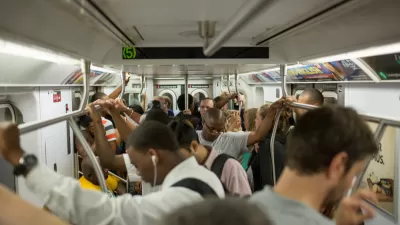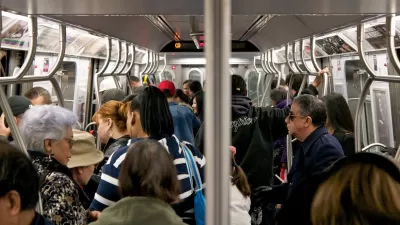The Atlantic has deep and detailed coverage of the expensive, obsolete, and decaying technology used by the New York subway system.
An incisive long read by James Somers details the missing links in the user experience of New York's subway system: countdown clocks and other mechanisms by which people can anticipate the arrival of trains. Somers starts the story with an anecdote about the Carroll Street station in Brooklyn, where transit riders stand outside the station to watch for the train's arrival—it's the only method of reconnaissance available:
"The only people who know exactly where that train is are on the train itself. The signal-tower operators don’t know; there’s no one in the Rail Control Center who could tell you, because the F isn’t hooked up to the Rail Control Center. Today, for the F train—along with the G, the A, B, C, D, E, J, M, N, Q, R, and Z—the best the system can say is that the train will get there when it gets there."
Any transit user can assess to the benefits of having reliable, real-time information about the arrival of their ride. Somers states it plainly that it shouldn’t be so difficult:
"It is easy to take for granted that governments move slowly, particularly on large infrastructure projects, particularly when those projects involve software. But we live in a world with cars that can drive themselves. Trains are huge objects that move in one dimension. How could it cost hundreds of millions of dollars and take nearly a decade just to figure out where they are and report that information to the public? Really: How?"
Somers proceeds to take a deep dive into the mechanics of the subway system a complex "of towers, signals, switches, and track sections" that is also "responsible for a disproportionate share of the costs and foibles in the operation and maintenance of New York’s subway system." The answer to all of these threats and malfunctions, according to the article is communications-based train control (CBTC). An MTA video, shown below, admits its faults in much the same way as detailed by Somers, in an effort to drum up support for CBTC.
As a counterpoint to the discussion about the current obsolescence of the system, Somers describes how a system using CBTC would work. Then this sobering statistic: "At the current pace of installation, the subway system as a whole won’t be converted to CBTC for another 175 years. It will cost $20 billion."
The story has a lot more on the many difficulties of upgrading the subway system, or as Somers puts it, "the story of a large organization’s first encounter with a large software project."
FULL STORY: Why New York Subway Lines Are Missing Countdown Clocks

Alabama: Trump Terminates Settlements for Black Communities Harmed By Raw Sewage
Trump deemed the landmark civil rights agreement “illegal DEI and environmental justice policy.”

Study: Maui’s Plan to Convert Vacation Rentals to Long-Term Housing Could Cause Nearly $1 Billion Economic Loss
The plan would reduce visitor accommodation by 25% resulting in 1,900 jobs lost.

Planetizen Federal Action Tracker
A weekly monitor of how Trump’s orders and actions are impacting planners and planning in America.

Restoring Northern India’s Himalayan ‘Water Temples’
Thousands of centuries-old buildings protect the region’s natural springs and serve as community wells and gathering places.

Milwaukee to Double Bike Share Stations
Bublr Bikes, one of the nation’s most successful, will add 500 new e-bikes to its system.

DC Extends Application Window for Outdoor Dining Permits
District restaurants will have until the end of November to apply, but businesses with permits in rush hour parking lanes must end operations on July 31.
Urban Design for Planners 1: Software Tools
This six-course series explores essential urban design concepts using open source software and equips planners with the tools they need to participate fully in the urban design process.
Planning for Universal Design
Learn the tools for implementing Universal Design in planning regulations.
Caltrans
Smith Gee Studio
Institute for Housing and Urban Development Studies (IHS)
City of Grandview
Harvard GSD Executive Education
Toledo-Lucas County Plan Commissions
Salt Lake City
NYU Wagner Graduate School of Public Service





























